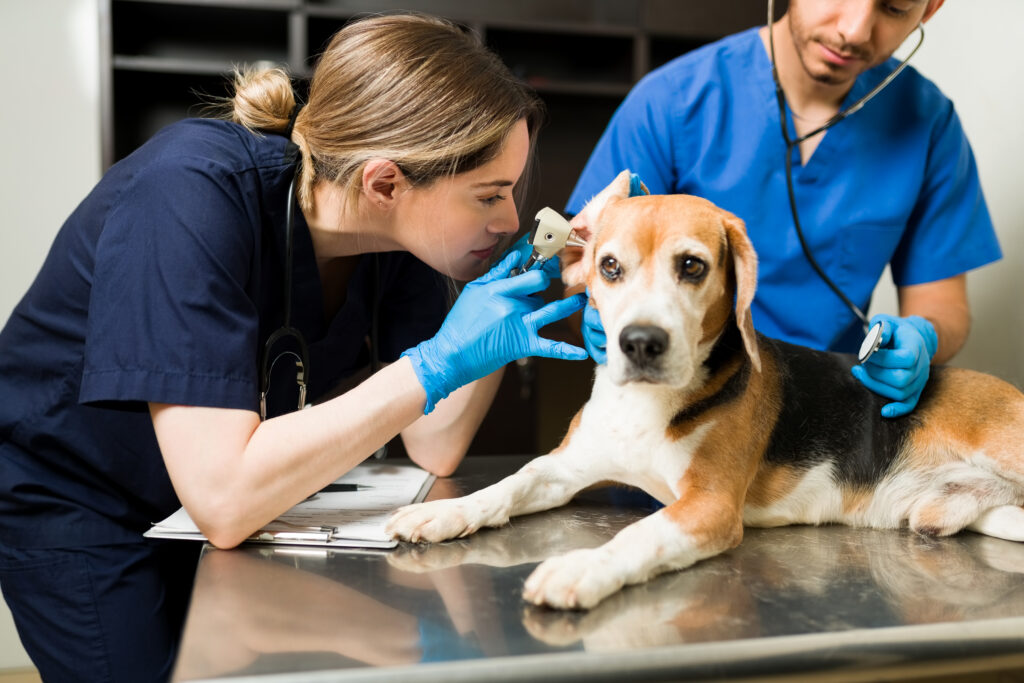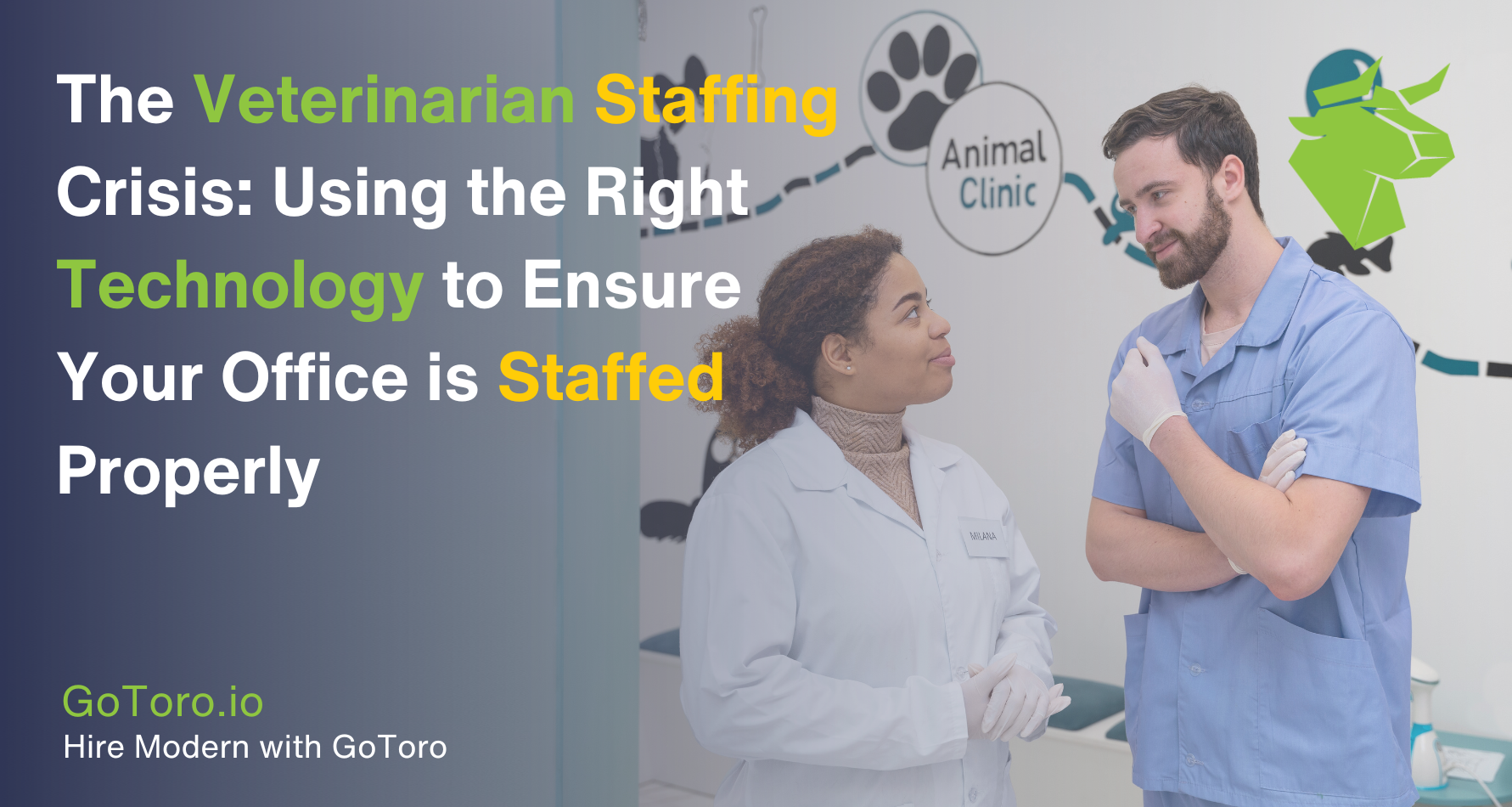GoToro knows the veterinary profession is currently facing a significant staffing crisis, with a marked shortage of qualified veterinarians to meet the growing demand for veterinary services. This crisis is felt across the spectrum of veterinary medicine. From small family practices to large veterinary hospitals, impacting both urban and rural areas. The consequences of this shortage are multifaceted, leading to increased wait times for appointments, burnout among existing staff due to overwork, and a decrease in the ability to provide comprehensive care for animals. The root causes of this crisis include a combination of an increasing pet population. As well as a greater demand for specialized veterinary services, and a limited number of veterinary graduates entering the workforce.
The Importance of Leveraging Technology and Strategic Approaches to Mitigate These Challenges
Addressing the veterinarian staffing crisis requires innovative and strategic solutions that go beyond traditional recruitment methods. Leveraging technology and adopting strategic approaches can play a pivotal role in mitigating these challenges. Technology can streamline many aspects of veterinary practice, from telemedicine services reducing the need for in-person visits to automated administrative tasks allowing veterinarians to focus more on clinical work. Additionally, strategic approaches to recruitment and retention, such as offering incentives, forming educational partnerships, and enhancing marketing efforts, can attract new talent and keep existing staff engaged and satisfied.
The Shortage of Veterinarians

Overview of the Veterinarian Staffing Issue
The shortage of veterinarians is a complex issue with regional variances. Rural areas, in particular, face acute shortages, affecting livestock care and thereby the agricultural industry. Urban areas, while better staffed, struggle to keep pace with the increasing demand for pet care services. This disparity leads to overburdened practices, with veterinarians often working long hours under stressful conditions, which can deter potential new recruits and exacerbate the shortage.
Strategic Solutions
Incentives for Veterinarian Staffing
To attract qualified candidates, veterinary practices are increasingly offering compelling incentives. These can include competitive signing bonuses, generous relocation assistance packages, and comprehensive benefits such as health insurance, retirement plans, and continuing education allowances. These incentives not only make positions more attractive to potential hires but also demonstrate a practice’s commitment to its staff’s well-being and professional growth.
Educational Partnerships
Collaborating with veterinary schools and offering internship and residency programs can be a game-changer for practices looking to bring in fresh talent. Such partnerships enable students to gain hands-on experience, making them more likely to consider employment offers from the practice upon graduation. Additionally, these programs can be tailored to fill specific needs within the practice, ensuring a good fit between the new veterinarians’ skills and the practice’s requirements.
Marketing Efforts
Effective marketing is crucial for attracting top talent. Practices should highlight the unique benefits of working with them, such as a supportive work environment, opportunities for professional development, and involvement in community outreach programs. Utilizing social media, professional networks, and veterinary conferences can help increase visibility among potential candidates. A targeted marketing approach that showcases a practice’s culture, mission, and the impact they make can differentiate them from other employers and attract individuals aligned with their values.
In conclusion, addressing the veterinarian staffing crisis requires a multifaceted approach that includes leveraging technology, offering competitive incentives, forming educational partnerships, and executing targeted marketing strategies. By adopting these strategic solutions, veterinary practices can attract and retain the talent needed to meet the demands of a growing and evolving veterinary landscape.
High Turnover Rates

Understanding the Problem
High turnover rates in veterinary practices are a growing concern. With significant implications for the quality of care, team morale, and the financial health of practices. The causes of high turnover are multifaceted, including job burnout, underappreciation, inadequate compensation, lack of career development opportunities, and poor work-life balance. The consequences are equally diverse, leading to disrupted patient care, decreased client satisfaction, increased workload for remaining staff, and the financial burden associated with recruiting and training new employees. Understanding these factors is critical to addressing the underlying issues and creating a more stable and satisfied workforce.
Mitigation Strategies
Exit Interviews
Conducting exit interviews with departing employees can provide invaluable insights into the reasons behind high turnover rates. These interviews offer a unique opportunity to gather honest feedback about the working environment, leadership, compensation, and the factors that contribute to job dissatisfaction. By analyzing this feedback, practices can identify patterns and implement targeted changes to address the root causes of turnover, ultimately making the practice a more attractive place to work.
Improving Workplace Culture
Enhancing workplace culture is vital for increasing employee satisfaction and retention. This can include fostering a supportive and inclusive environment. As well as recognizing and rewarding employees’ contributions, offering professional development opportunities, and encouraging open communication. A positive workplace culture not only improves job satisfaction but also attracts new talent by establishing the practice as a desirable place to work.
Competitive Compensation
Offering competitive salaries and benefits is essential to attract and retain top talent. Beyond basic salary, benefits such as health insurance, retirement plans, paid time off, and allowances for continuing education and professional development can make a significant difference. Practices need to regularly review and adjust their compensation packages to ensure they remain competitive in the evolving veterinary job market.
Work-Life Balance Concerns
Challenges in Veterinary Medicine
The demanding nature of veterinary medicine, with long hours, emergency calls, and the emotional toll of caring for sick and injured animals, can significantly impact work-life balance. These challenges can lead to job dissatisfaction, burnout, and ultimately contribute to high turnover rates. Addressing these concerns is crucial for the well-being of veterinary professionals and the sustainability of the practice.
Balancing Veterinarian Staffing Strategies

Flexible Scheduling
Implementing flexible scheduling can help accommodate employees’ personal commitments and preferences, contributing to a better work-life balance. Options such as compressed workweeks, part-time positions, and rotating shifts can allow staff to balance professional responsibilities with personal life, leading to increased job satisfaction and retention.
Staffing Levels
Ensuring adequate staffing levels is essential to reduce individual workloads and prevent burnout. By maintaining a sufficient number of staff, practices can distribute work more evenly, allow for more manageable schedules, and reduce the pressure on each team member. This approach not only improves work-life balance but also allows for a higher quality of patient care.
Mental Health Support
Providing resources to support employee mental health is increasingly recognized as a critical component of workplace wellness. This can include access to counseling services, stress management programs, and initiatives to promote a healthy work-life balance. Supporting mental health in the workplace can help prevent burnout, increase employee satisfaction, and contribute to a more positive and productive work environment.
In conclusion, addressing high turnover rates and work-life balance concerns in veterinary practices requires a comprehensive and proactive approach. By understanding the underlying issues, implementing targeted strategies, and continuously seeking to improve the working environment, practices can enhance employee satisfaction, reduce turnover, and build a more resilient and committed workforce.
Skill Shortages
Identifying Gaps
In the veterinary field, skill shortages are particularly pronounced in areas such as emergency and critical care, surgery, and certain types of specialty medicine (e.g., oncology, neurology). These shortages can limit a practice’s ability to provide comprehensive care and respond to complex cases. Additionally, there’s a growing need for expertise in emerging areas such as animal behavior, holistic treatments, and advanced diagnostic imaging. Identifying these gaps is the first step toward addressing them, ensuring that veterinary practices can meet the full range of their patients’ needs.
Solutions for Skill Development

Training and Education
Investing in the ongoing training and education of veterinary staff can significantly mitigate skill shortages. Providing access to continuing education courses, workshops, and seminars enables existing staff to expand their knowledge base and acquire new skills. This not only helps fill the skill gaps within the practice but also enhances job satisfaction and retention by offering career development opportunities.
Specialist Collaboration
Partnering with veterinary specialists can enhance a practice’s service offerings and address areas of skill shortage. By establishing relationships with specialists in fields like surgery, dentistry, or cardiology, general practices can offer a broader range of services, improve patient outcomes, and provide learning opportunities for their staff. This collaborative approach can also be appealing to pet owners seeking comprehensive care under one roof.
Recruitment Efforts
Expanding recruitment efforts to broader regions, including internationally, can help address skill shortages. This involves actively seeking out professionals with the desired expertise and offering attractive incentives such as relocation assistance. In addition to competitive compensation packages, and professional development opportunities. Recruitment strategies should also emphasize the practice’s strengths and unique offerings to stand out in a competitive job market.
Competition from Other Employers
Navigating Competitive Landscapes
The competition for qualified veterinary staff is intense, with practices vying for a limited pool of skilled professionals. Understanding the competitive landscape is crucial for developing effective recruitment and retention strategies. This includes awareness of what other employers offer in terms of compensation, benefits, work environment, and professional development opportunities.
Differentiation Strategies
Unique Selling Points
Highlighting what makes your practice unique is vital in attracting and retaining talent. This could include a focus on specific types of care or services, a strong commitment to employee well-being, innovative use of technology, or a supportive and collaborative work culture. Emphasizing these unique selling points can make your practice more attractive to prospective employees.
Employer Branding
Building a positive employer brand is essential in today’s competitive job market. This can be achieved through positive online reviews, an active and engaging social media presence, and showcasing employee testimonials. A strong employer brand that reflects a positive work environment, a commitment to quality care, and employee satisfaction can attract top talent.
Community and Industry Engagement
Engaging with the veterinary community and industry organizations can strengthen your practice’s presence and reputation. This includes participating in industry conferences, collaborating with veterinary schools for internships and residencies, and engaging in community outreach programs. Such engagement not only helps in recruitment but also establishes your practice as a leader and innovator in the field.
In conclusion, addressing skill shortages and navigating the competitive landscape requires a multi-faceted approach focused on skill development, strategic recruitment, and effective differentiation. By investing in training and education, collaborating with specialists, expanding recruitment efforts, and building a strong employer brand. Veterinary practices can attract and retain the skilled professionals needed to provide the highest level of care and service.
Addressing the veterinarian staffing crisis requires innovative and multifaceted strategies. Including the integration of technology and strategic solutions such as competitive incentives, educational partnerships, and a focus on workplace culture. Veterinary practices are urged to adopt these comprehensive approaches to not only fill current vacancies but also ensure a sustainable and fulfilling work environment for their staff. By doing so, they can improve the quality of care provided to animals. In addition to enhancing overall job satisfaction among veterinary professionals.
To see how these technologies and solutions can be implemented in your practice, request a demo today!


